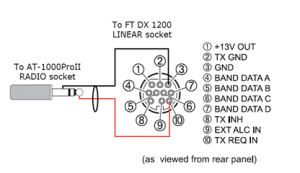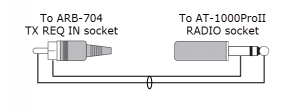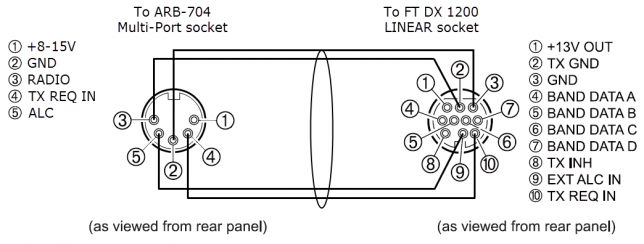In September of 2014 I purchased an LDG Electronics AT-1000ProII Autotuner and M-1000 External Meter from a local distributor in Sydney, Australia and I must say I am very pleased with my decision. The tuner works great with my Yaesu FT DX 1200 exciter and Ameritron AL-811H linear!
The FTDX 1200 has a TX REQ IN input on the 10-pin mini DIN LINEAR socket, so I decided to fashion my own interface cable to connect this input to the AT-1000ProII RADIO socket so that the tuner can request the exciter to generate a tuning carrier:

Using screened cable I connected a 3.5mm stereo plug tip to TX REQ IN on pin 10 of a 10-pin mini DIN plug, left the ring unconnected and connected the sleeve to GND on the pin 3 of the 10-pin mini DIN plug. The stereo plug was inserted into the AT-1000ProII RADIO socket and the 10-pin mini DIN plug was inserted into the FTDX1200 rear panel LINEAR socket.
When I initiated a manual full tune with a long press of the Tune button on the AT-1000ProII, the exciter was keyed in CW mode until the tuner found a match. However, when I initiated a manual memory tune with a medium press of the Tune button on the AT-1000ProII, the exciter was not keyed and the tuner displayed the ERR_NO_RF error indication with one blink of the PWR LEDs. The REV A manual indicates on page 15 that one button tuning should work in both manual full and manual memory tuning modes. I emailed LDG Electronics but the reply suggesting it might be a timing issue was not very helpful.
I determined the firmware version to be 1.4 as printed on a sticker on the processor inside the AT-1000ProII and found that a later version was available from LDG Electronics. So I placed an order for a replacement processor chip with the latest version 1.7 firmware. After I installed the new processor, everything worked as expected – both manual full and manual memory tuning requests triggered the tuning carrier from the exciter.
I have not found any other issues with the AT-1000ProII Autotuner and would advise anyone purchasing one, to upgrade to version 1.7 firmware which at the time of writing is still the latest version.
73 Chris
VK2BYI




